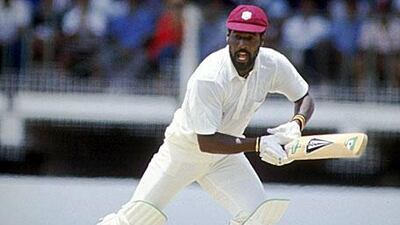On Sunday night in the Caribbean, a group of players will be able to do something the likes of Sir Garry Sobers, Barry Richards, Denis Compton, Mike Proctor and even Sir Donald Bradman never could. They will call themselves cricket world champions.
The golden ages of cricket were often played out with little more at stake than pride, or the promise of expenses for the train fare. How Twenty20 has changed the landscape of cricket during its short lifespan. Now players can earn astronomical fees for three hours of hit-and-giggle cricket, as well as a medal to say they are the best in the world at it. If Tyron Henderson, one of the costliest flambes in the T20 pan, could command a price of US$650,000 (Dh2.3m) at auction, what might Sobers have earned? Here we pick a side from the annals of history who were old too soon for the T20 revolution, but who would surely have been stars in this arena. (With apologies to Sobers, Richards, Compton, Proctor and Bradman, you were too good for this format.)
Viv Richards (Windies) Richards retired more than a decade before T20 was first introduced to professional cricket, but he had been playing his own version of it for years anyway. There have been slower centuries hit in the 20-over format than the one the Antiguan master managed against England in 1986. His 56-ball masterpiece remains the fastest in Test history.
David Hookes (Australia) "Marshy's takin' wickets, Hookesy's clearin' pickets." So went C'mon Aussie, C'mon, the song penned to promote World Series Cricket in the late 1970s. Kerry Packer was so intent on landing the whizz-kid Hookes for his new tournament he granted him two-thirds of his fee in advance. Established stars such as the Chappell brothers had to make do with half. Mike Llewellyn (Glamorgan) Every successful T20 side needs its wildcard selection, a bolter from the backwaters. If big-hitting is the staple, then Llewellyn, a stocky Welshman who played 143 one-day matches but none at international level, is the man. He smashed John Emburey, the England spinner, on to the roof of the Lord's pavilion in a cup final in 1977.
Gordon Greenidge (Windies) Cuthbert, which is Greenidge's Christian name, seems more suited to the fops who are bullied by Dennis the Menace in The Beano. Yet for most of his 21-year career, Greenidge was the one doing the bullying. Rarely in the history of the game have new-ball attacks had the ball coming back at them as hard as when the Barbadian was on strike.
Graham Gooch (England) With a railway sleeper for a bat and a keen grasp of how beneficial a trip to the gym could be, Gooch was way ahead of his time, and set the mould for the T20 batsman. The Essex opener took England to their last major final in a limited-overs competition, and had a healthy average in excess of 42 in one-day internationals.
Albert Trott (Eng and Aus) Who needs Andrew Symonds when we have got Albert Trott? English/Australian identity crisis? Check. Regularly falls foul of selectors? Check. Crowd-pleaser? Check. Can hit the ball over the Lord's pavilion? Symonds has never got close to that feat, which Trott managed with one famous strike in 1899. And with an old-fashioned bat, too. Farokh Engineer (India) "He's mad," Engineer, the former India wicketkeeper, said of Shahid Afridi during a trip to Dubai in 2005. "I know he's mad, because he plays the sort of shots that only I would have tried." Engineer's modus operandi once brought him 94 before lunch in a Test against the Windies, and made him one of his era's most watchable players.
Kapil Dev (India) Shane Warne, the IPL captaincy king, deems the No 8 slot to be vital in T20 cricket. The four successive sixes Dev took from Eddie Hemmings to save the follow-on in the 1990 Lord's Test suggest he would have been perfectly suited to the role. Then there is the added bonus of his 434 Test wickets and World Cup winning leadership.
Gavin Larsen (N Zealand) Accepted wisdom has it that taking the pace off the ball is the key to stemming runs in limited-overs cricket. Larsen could probably run faster than he bowled it. With his slow-medium pacers, he had an economy rate of 3.75 per over in 121 ODIs for New Zealand, earning himself the nickname of "Postman", because he always delivered. Abdul Qadir (Pakistan) The presence of a mystery spinner is crucial in this format, and few have been more bewitching than the Lahori leg-spin legend. With more tricks than Houdini, and a competitive streak which once saw him wade into the crowd in the West Indies to settle an argument with a barracker, Qadir would have been a ideally suited to T20.
Joel Garner (West Indies) Despite all the innovation that abounds in T20 cricket, no one has yet come up with a convincing and fail-safe method for countering a perfectly delivered yorker. Garner was, arguably, the greatest ever exponent of the sand-shoe crusher. His five wickets for 38 against England in 1979 remain the best figures in a World Cup final. @Email:pradley@thenational.ae


